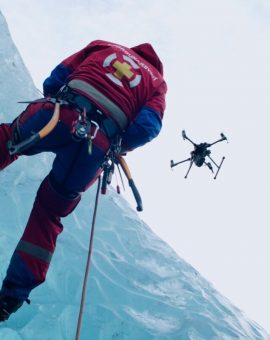From Passion to Profession: Navigating the World of Commercial Drones
Remember that thrill the first time you launched a drone? The world shrinking beneath you, the exhilarating buzz of the rotors, the unique perspective from above. For many, what starts as a captivating hobby quickly sparks a question: Can I actually make a living doing this?
The answer, definitively, is yes. The commercial drone industry is soaring, transforming operations across countless sectors. What was once the domain of niche enthusiasts is now a vibrant, rapidly growing professional landscape. If you’re looking to transform your love for flying into a sky-high career, here’s your guide to navigating the world of commercial drone applications.
The Drone Revolution: More Than Just a Toy
Drones are no longer just for capturing stunning vacation footage (though they excel at that!). They are powerful tools delivering unparalleled efficiency, safety, and data in industries such as:
- Real Estate & Architecture: Breathtaking aerial tours, progress monitoring for construction projects, detailed site surveys.
- Agriculture: Precision farming, crop health monitoring, irrigation analysis, livestock management.
- Inspection: Safe and efficient inspection of critical infrastructure like bridges, power lines, wind turbines, and solar panels, often reaching areas too dangerous or costly for humans.
- Filmmaking & Photography: Dynamic cinematic shots, unique perspectives for events, advertising, and documentaries.
- Mapping & Surveying: Creating highly accurate 3D models, topographic maps, and precise measurements.
- Public Safety: Search and rescue, disaster response, incident scene analysis for law enforcement.
- Logistics & Delivery: (Emerging) Parcel delivery, medical supplies transport.
This diverse demand creates a wealth of opportunities for skilled drone professionals.
Bridging the Gap: From Enthusiast to Entrepreneur
So, how do you make the leap? It involves more than just being a good pilot.
1. Get Licensed (Legally Certified)
This is the non-negotiable first step. In the United States, this means obtaining your FAA Part 107 Remote Pilot Certificate. This isn’t just about knowing how to fly; it’s about understanding airspace regulations, weather, aircraft loading, emergency procedures, and operational limitations. Similar certifications exist in other countries (e.g., A2 C of C/GVC in the UK, various certifications in Canada and Europe). Without it, you cannot legally operate a drone for commercial purposes.
2. Master Your Craft (Beyond the Basics)
Being proficient at hovering is just the start. Commercial operations demand:
- Advanced Flight Skills: Precision maneuvers, flying in various conditions, understanding flight modes for different tasks.
- Data Acquisition: Knowing how to capture the right data – whether it’s specific camera settings for photography, overlap for mapping, or thermal imaging techniques for inspections.
- Post-Processing Expertise: Learning software for photo/video editing (e.g., Adobe Premiere Pro, Lightroom), photogrammetry (e.g., Pix4D, DroneDeploy), or CAD tools. The data is only valuable if it can be processed and presented effectively.
3. Invest Wisely (Gear & Knowledge)
While you don’t need the most expensive drone to start, you’ll likely need gear suited for professional tasks. Consider:
- Reliable Drones: DJI Mavic series, Autel Evo, or more specialized platforms like the Matrice for industrial applications.
- Essential Accessories: Extra batteries, ND filters, robust cases, high-capacity SD cards.
- Software Licenses: For editing, mapping, or 3D modeling.
- Insurance: Commercial drone liability insurance is crucial to protect yourself and your clients.
- Continuous Learning: The technology evolves rapidly. Stay updated through courses, workshops, and industry publications.
4. Find Your Niche (Specialization is Key)
While it’s tempting to try everything, specializing often leads to greater success. Do you have a background in construction? Focus on site progression and inspection. Are you a talented videographer? Hone your cinematic drone skills. By becoming an expert in a specific area, you can better market your services and command higher rates.
5. Build Your Brand (and Portfolio)
Your work speaks for itself. Create a professional website or online portfolio showcasing your best work. High-quality imagery and video, client testimonials, and clear communication of your services are vital. Develop a professional image for your business.
6. Network, Network, Network (Connect & Collaborate)
Attend industry conferences, join online forums, and connect with other drone pilots and potential clients. Often, the best opportunities come through referrals and collaborations. Building relationships is as important as building skills.
Challenges & Considerations
It’s not all smooth flying. Be prepared for:
- Evolving Regulations: Laws and airspace restrictions can change. Stay informed.
- Competition: The market is growing, so differentiate yourself with quality and specialization.
- Weather: Unpredictable weather can delay or cancel jobs.
- Maintenance & Upkeep: Drones require care, and repairs can be costly.
- Client Education: Sometimes you’ll need to educate clients on what drones can and cannot do.
The Future is Flying High
The drone industry is still in its early stages, with new applications and technologies emerging constantly. From AI-powered flight control to autonomous inspection and larger-scale delivery operations, the potential is immense. Now is an exciting time to be part of this revolution.
If you have the passion, are willing to put in the work to become professional, and are committed to continuous learning, the sky literally holds no limits for your drone career.













